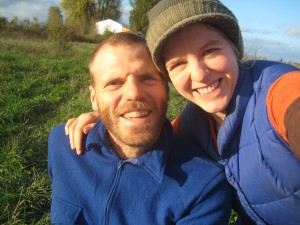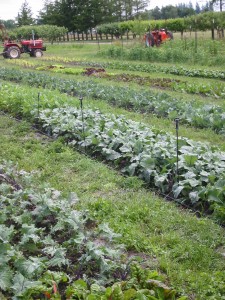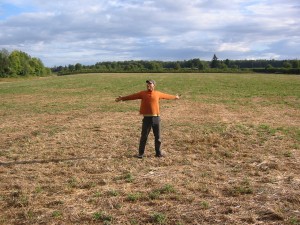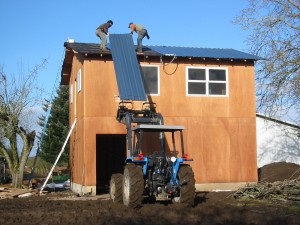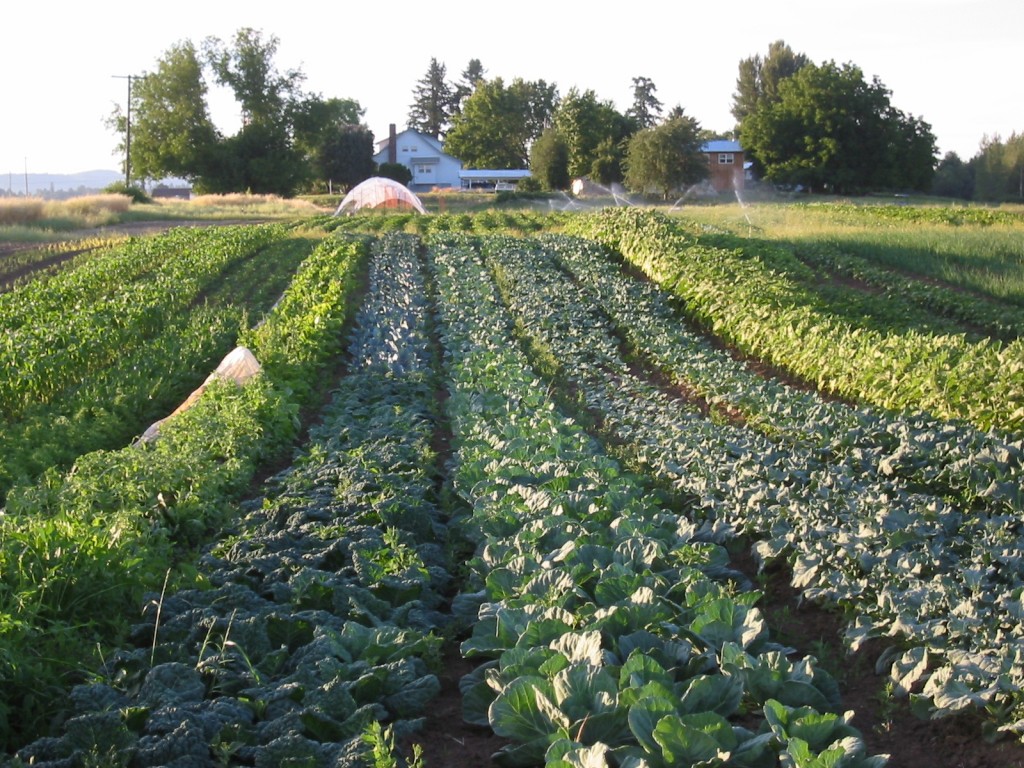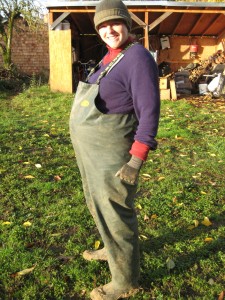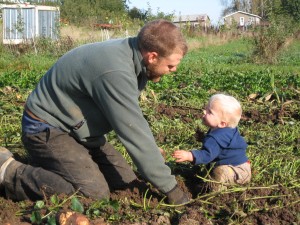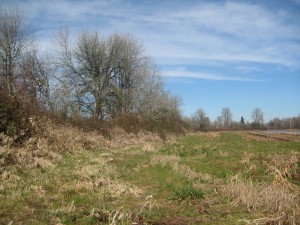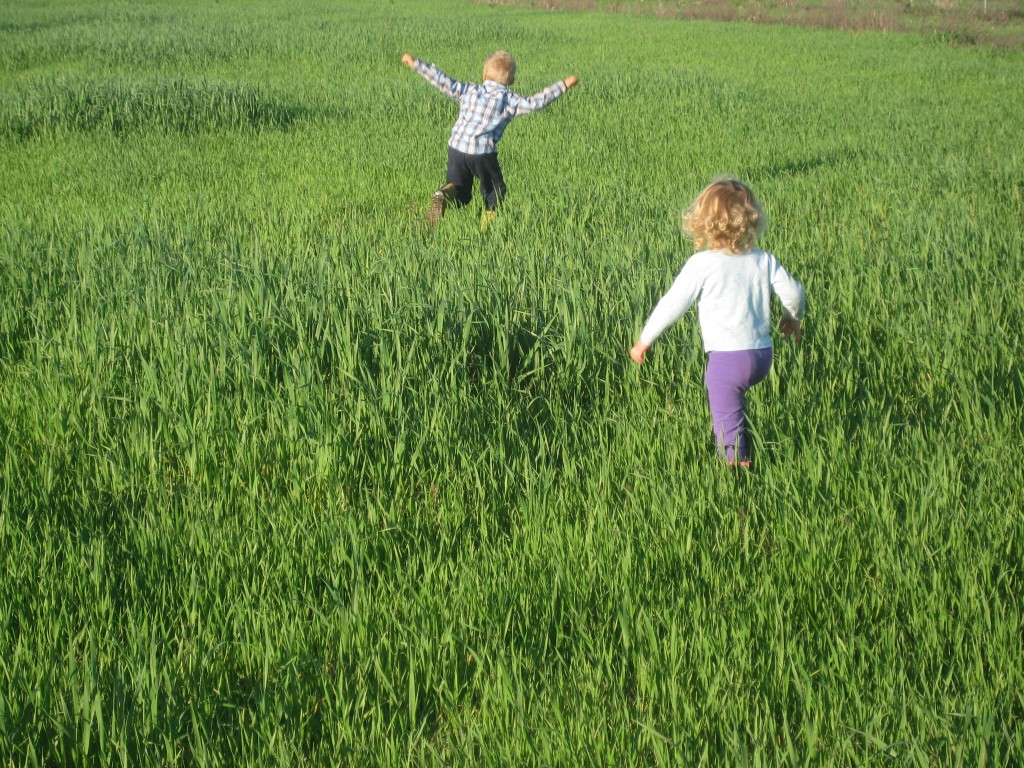Hello! We are Casey and Katie Kulla, your farmers. Here is a bit of our story and how we came to inhabit and farm an amazing piece of land here on Grand Island (a bit more about the land itself too, since its story has become part of our story). Much of this is already well documented on our farm blog, but newcomers to our story may not have time to back-read hundreds and hundreds of newsletters, so here is the shorter version of it all:
We met in 1998, as freshman in college in Washington state. Little did we know where our life together would take us when we married in 2000 (yes, we were quite young!). Casey got the “farming bug” soon after we married, thanks to reading The Unsettling of America by Wendell Berry. It took me, Katie, a few more years to get on board with that idea, but I got hooked on the idea of farming while working in a kitchen at a remote retreat center where most of the food was procured from nearby farms. That was some good food!
Starting in 2004, Casey and I spent two years working on Cedarville Farm, an organic vegetable farm in Bellingham, Washington. We simultaneously earned Master’s degrees from Western Washington University (Creative Non-fiction for me; Ecology for Casey). Even though our graduate school experiences were formative, the side-by-side experiential trial left us without a doubt that we wanted to pursue farming as our primary occupation.
We began scouting in the Willamette Valley for a potential farm home, brought to the area by its proximity to Casey’s family (he grew up in Lincoln City), good markets, and amazing farmland. In spring of 2006, the universe directed us to McMinnville, and we listened and found opportunities here that exceeded our expectations all around. That first year, we rented one acre of ground on the northwest side of town, where we were able to set up operations quickly thanks to the existing infrastructure and tools used by our landlords when they had operated their own small farm on the land a few years prior. We sold vegetables at the McMinnville Farmers Market and started our vegetable CSA right away that year.
Meanwhile, we kept seeking a permanent farm home. We dreamed of really putting down roots in one place and tending to the land for decades. When we had first visited Yamhill County looking for land, we had checked out a 17.5 acre parcel on Grand Island that was for sale but that we thought we could never afford. It had everything we were looking for: class-1 soils, water rights, a building site. Plus, it was on this really cool agricultural island at the southeast corner of Yamhill County (a community we were quickly falling in love with and were hoping to stay in forever). We kept visiting that land and dreaming, even though it seemed beyond our reach.
One day in early summer, my parents came to visit us from their home in the Seattle area. We drove them out to see this dream land right at golden hour before dusk and said, “We want you to be a part of this magic.” The next day, they called the local hospital to inquire about job openings for anesthesiologists (my dad’s profession) — they had posted a job listing that very same day. We all felt the pull of the opportunity.
And, so by the end of our first season farming in Yamhill County, my parents had moved here too. They helped us buy that dream land, originally with the intention of building there too, but that plan didn’t come to fruition and they moved elsewhere in the area, so we are paying them back now for the loan. Another friend we knew from that very same freshman year dorm loaned us another big chunk of the money. Purchasing our farm home was a community effort and one of the biggest blessings of our entire life.
Since that first season, the farming adventures have continued. That winter after buying our land, we built a house! This was a lifelong dream for both us, and one which was simultaneously amazing, humbling, maddening, and extremely satisfying (yes, all of those!). We built a little house with our own hands, with plenty of help from friends, family and CSA customers. Another community effort and blessing in our lives. We have lived here on the farm in this little house since Earth Day of 2007.
For the first three years of the farm, Casey and I were the only full-time farmers in the fields. We had a few friends who volunteered regularly, which helped keep us going, but we did the bulk of the work ourselves: tractoring, planting, weeding, and harvesting for our market customers and our year-round CSA. We also spent those years building our farm’s infrastructure and learning how to grow really good vegetables.
In 2009, we made some changes. We stopped going to market in order to focus on our CSA, which had a growing waiting list. And, we added a few significant new faces on the farm. We hired our first employees (the first of many over the years), a lovely couple who spent the summer working side-by-side with us. Their presence allowed us to expand the acreage under our management, as we took over a lease of our next-door neighbor’s fields (taking our acres in cultivation from 12.5 to 16 — giving us extra space for longer rotations and more cover crops). At the end of 2009, we also welcomed our first child, Russell Sprout (“Rusty”), who was born here in the little house we built (I worked in the fields until the day I went into labor! A wonderful way to spend a first pregnancy).
We kept on farming, albeit with less hands-on help from me in the fields (I’m still here, taking care of lots of details from the house!). That first year of Rusty’s life rocked our world in so many wonderful ways. In addition to deepening our understanding of what it means to be a family farm, we found ourselves in the midst of an intense community organizing experience. Early in 2010, a gravel quarry put in an application to operate here on 225 acres of Grand Island farmland. Folks here on the island and beyond were horrified at the prospect, and we spent many days and evenings meeting with neighbors, gathering petitions, organizing, and providing testimony to the county against this possible permanent destruction of prime farmland. We literally put hundreds of hours into this effort, and yet the county did eventually approve the application for a zoning change. The quarry has not yet been permitted and is not yet operating.
The incredible silver lining of that hard process was that Casey and I finally got to meet and know many of our neighbors (Grand Island is a quiet community, and it takes people awhile to connect).
Some of these neighbors and new friends were looking to sell land on the island. The family patriarch was ailing, and none of the younger generation were farming. Casey and I were keenly aware that we wanted to keep farmland in farming on Grand Island, and the parcels in question were adjacent to our farm. We took it on as a personal mission to find farmers to buy and farm this land. We knew many farmers looking for land, but for some reason, it just wasn’t clicking for anyone. We were baffled! How could these people not want to buy this beautiful land with water rights? Eventually, we realized: oh, perhaps we should buy it. And, amazingly enough, at that point in our farm’s journey, we could afford to do so. With quite a lot of effort, we even managed to secure a bank loan for the purchase — approved on the merits of our farm as a business (hoorah!). So, in early 2011, we purchased an additional 31 acres adjacent to our farm, and at the same time a friend in the area purchased the other 54 acres, which we agreed to lease.
I should back up and add another important detail: early in 2009, our next-door neighbor (whose land we were leasing) passed away. His widow knew that my parents were interested in buying that property eventually (the two houses are quite close together and share a driveway), and in early 2010 she sold it to my parents. They remodeled the old farmhouse and moved out here (with their sheep!) to the farm the month before we closed on our new land — quite a spring for us! We found ourselves suddenly living side-by-side with my parents and owning/renting over 100 acres of land! In our wildest dreams, we could never have predicted all of that happening.
Fortunately for us, that ailing patriarch wanted to make sure the farmer who had been leasing his land could finish out his season, so we did not take over management of all that new land immediately. We were given some extra time to plan and organize ourselves. We agreed to take on 10 acres that first year, and then we took over the rest fall of 2011.
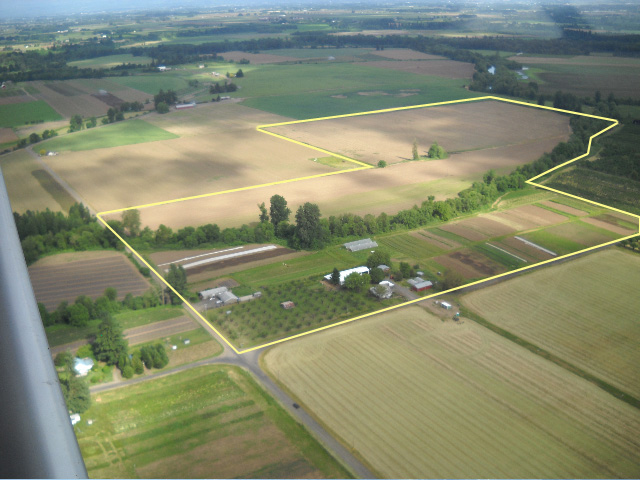
The farm in 2011 — the yellow line outlines all of it: our home farm (on the lower right, you can see rows of veggies), my parents’ property next-door, and the two new parcels above the creek. At the time of the picture, they were still being farmed by the former leasing farmer. The picture would look very different today!
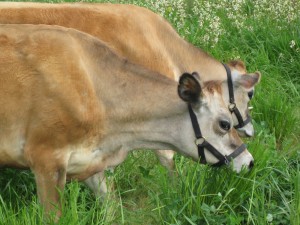
Our first dairy cows, Willa and Annie, brought us lots of stress and eventually lots of delicious milk (and at least one kick to Casey’s head).
2012 was quite the year. We began the big work of managing 100+ acres; we added animals to our farm (you can read more about that on our animal page); we welcomed our second child, Dorothy Raven (“Dottie”); and Casey was diagnosed with a malignant melanoma and had a major surgery at the end of the year. What a year. That was one for the history books, and we are glad to have it behind us.
The hard work of 2012 yielded some amazing adventures for us and everyone associated with the farm. Our farm became less of a “garden” and more of a “farm.” Our farm still contained gardens of vegetables (oh yes! we love growing vegetables), as well as orchards (three of which we planted over the years), berry patches, pastures, nut groves, fields of grain, and many, many wild areas at all the edges. It felt wild in every way for a few years there as we expanded and grew.
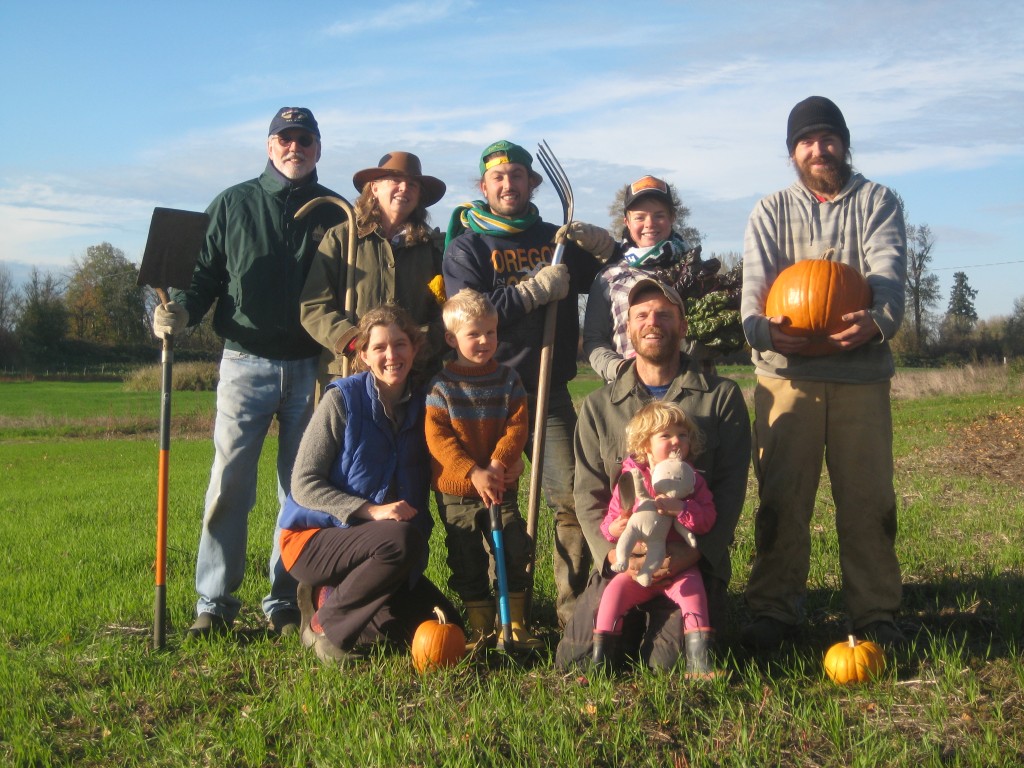
The 2014 farm folk — in front: Katie, Casey, and kids. In back: Katie’s parents, Steve and Kris, Jasper, Sarah and Nathan (not pictured: José).
Since the peak of enterprises, employees, and acreage that occurred in 2012-2014, we have begun to pull back again. We have found ourselves drawn back toward simplicity on the farm and in our lives. We found ourselves once again smitten by vegetable gardening and a family farm that is just our family.
Beginning at the end of 2015, we said good-bye to our last (and well beloved) employee and began decreasing the amount of acreage under our direct management. For a time, we loved the wildness of our wild farm adventure, and now we are ready to recommit ourselves to the craft of growing — to the attention to detail possible when we ourselves do all the work (and don’t do too much of it!).
The farm is always in flux. This is part of what we have always loved about farming — the ability to create and grow and fine tune and try new things and revisit old ideas. We have endless opportunities to tinker and watch and observe and change. Each time we slightly change how we farm, we do so with new knowledge and experience guiding us. We live in the midst of a dynamic place, and we are dynamic people. We love it here. We love this work.
That’s the basic outline of how our farm came to be what it is today.
I want to close with a few more words about the place itself. The word “place” suggests an outline around a piece of land. And, yes, there are definitely theoretical outlines that determine where our responsible for this place start and end (and let me tell you, boundaries are important in rural relationships!). But, for us, this farm is a center of something so much bigger — Grand Island, the Willamette Valley, Oregon, the West Coast … We love the bigger places too, and explore them as much as we can. Yet these acres that we walk and explore and farm are the foundation of our experience. They are our responsibility and home. We love them more and more every day, and increase in our understanding of them with every passing year.
But, although we are farmers and grow food, we have no desire to tame or tidy this place. Our farm is still so very wild, so very jagged around its edges. We are not afraid of weeds or gophers, and we welcome the natural processes that make our farm thrive — the sunlight’s power; the fungi in our soil; the wind that tests our greenhouses’ strength; the flood waters that connect our farm to the river every winter.
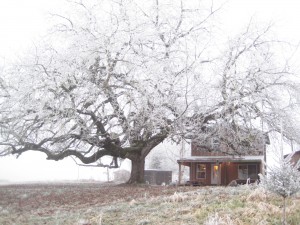 Every day here humbles us. Every day here brings challenges. Every day here teaches us about the abundance of the universe, as we experience the power in nature and the generosity in people and their connections. Every day here is an honor. Every day we learn more about what it means to be rooted here — all the complications of staying put and loving a little corner of the world so hard.
Every day here humbles us. Every day here brings challenges. Every day here teaches us about the abundance of the universe, as we experience the power in nature and the generosity in people and their connections. Every day here is an honor. Every day we learn more about what it means to be rooted here — all the complications of staying put and loving a little corner of the world so hard.
So many years ago, it was Wendell Berry that inspired this journey. I can’t think of a better way to pause in this ongoing story than with some of his words:
from Prayers and Sayings of the Mad Farmer
~ Wendell BerryIX
Sowing the seed,
my hand is one with the earth.Wanting the seed to grow,
my mind is one with the light.Hoeing the crop,
my hands are one with the rain.Having cared for the plants,
my mind is one with the air.Hungry and trusting,
my mind is one with the earth.Eating the fruit,
my body is one with the earth.

